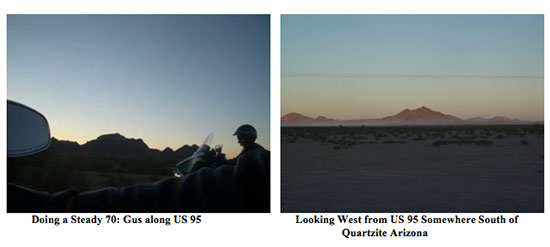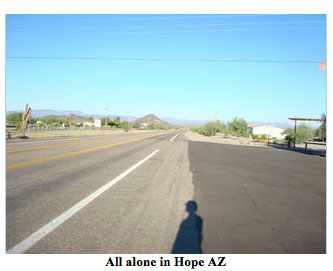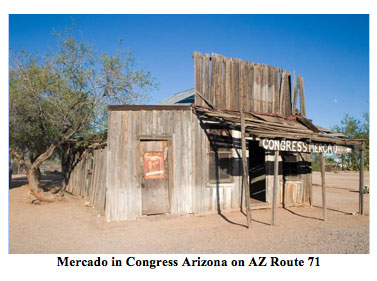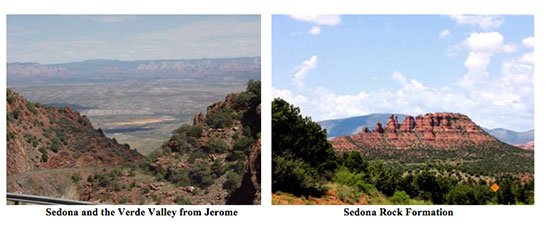Life and Island Times: A War Zone and a Dead Zone
They slept in a heavenly peace after each consumed a sacred trinity the previous night at Chretin’s: a large 3-way enchilada dinner, 3 dozen nachos and 3 family sized troughs of margaritas. Anticipating a rocket-assisted lift off the next morning due to nacho ingestion, they took several purple pills before commencing their nightly search for REM stage sleep. They awoke with minimal scorching of their launch pads.
They loaded up their bikes the next morning more than an hour before sun up. It would be a chilly ride northward into the Arizona hills and high desert. Once they exited Yuma, the temperature dropped another 15 degrees. They hoped their winter gloves would prevent their fingers cramping.
The sunrise would be on their right and of the intermittent variety due to the north-south mountain ranges that protected their northbound formation’s eastern flank. They were well north of town when they saw up high in the far distance the dark outline of a motionless INS aerostat or tethered blimp chockfull of sensors.
More than 60 miles from the border from Mexico, they had stumbled smack dab into the middle of a war zone. The battlefield was in the middle of the Yuma Proving Ground along US route 95. Amercia’s outnumbered anti-immigration troops attempted to even the battle with force-multiplying, technical virtuosity. It was a strategy that Cold Warriors had effectively used to even the US’s fight against the numerically superior Soviet submarine fleet missile menace off of the US coasts.
The blimp’s sensors implacably stared southward over the immense Sonoran Desert flatland that narrowed to the north thus funneling the INS’ prey. As they passed the blimp to their right, they noticed that they could not hear its station-keeping engines or props. The immigrants’ stealth had been parried with counter-stealth technology. Another Cold War technology game had found a new venue.
Several miles later abeam Castle Dome Peak at the head of a narrow canyon, they slowed down in the dawn light to pass through an immigration control point. US forces meant business. They spotted bullet proof vested, fatigue-wearing warriors heavily armed with holstered side arms and shouldered M16s. They silently waved the riders through the checkpoint. They waved back and wished them well. Their warm words of welcome physically manifested themselves when they were steamed into existence by the dark desert’s freeze-drying air.
For the most part the US Navy had succeeded in its four-decade long, deterrence shadow war against the commie’s ballistic missile boats. The INS campaign to counter the human wave attacks numbering in the thousands of souls per day didn’t seem to be going well.
As the sun rose, they made it to the first checkpoint at Quartzite and turned briefly onto I10 and before continuing onto the next desert backcountry road, US 60.

They needed some gas and a chance to unclench their frozen bones so they stopped in the town of Hope. Unknowingly, in less than 30 miles since the INS checkpoint, they had exited the immigration war zone and entered a dead zone devoid of human activity despite the buildings and town markers.
Named in the hope for increased business after the state relocated a main road in 1920 through the place, Hope consisted of one empty RV park, one lonely gas station, and one dilapidated antique store. Augustus’s iconic Twilight Zone image said it all about this place called Hope.

They remained suspended for a long time in this Rod Serling dead zone. Not until they were within 90 miles of Flagstaff and observed the reemergence of walking and talking human beings upon the landscape were they certain that they had exited this lifeless sector. Here is another unsettling image of the barrenness they saw.

They slowed the pace down repeatedly along Arizona routes 89 and 89A due to the scenery in Prescott, Jerome and Sedona. Some consider the telegenic Sedona area as the most beautiful place in the USA. Its timeless red rocks first fired the imaginations of American Indian settlers more than eleven millennia ago. Subsequent 19th century homesteaders, 20th century artists and New Age spiritualists have been beguiled as well. From the observed increase in live green signage cheek by jowl with the cancerous spread of real estate development since their last visit in 2001, competing agendas abound for this Eden.

By midday with the temperatures soaring, they wisely stopped for the day in Flagstaff after 320 miles. They had hoped to rendezvous with Steve that night in Flagstaff. The heat in Mojave Desert’s dead zone nearly got him, so he ended his journey a 150 miles short of Flagstaff in Kingman. They agreed to join Steve in Albuquerque New Mexico at his sister’s house.
Copyright © 2017 From My Isle Seat
www.vicsocotra.com
